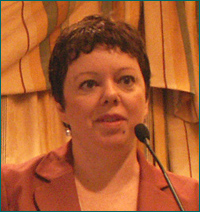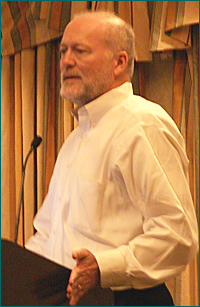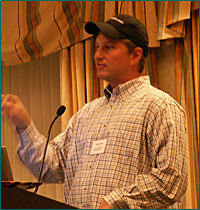PANEL HIGHLIGHTS

Mary Lou Fulton, VP/ Audience Development, The Bakersfield Californian
Steve Yelvington, VP/ Strategy & Content, Morris Digital Works
Travis Henry, Editor, YourHub.com
OVERVIEW
As mainstream media outlets struggle to reverse steep drops in circulation, the emerging and fast-expanding new models of citizen media could offer some salvation. From the coastline of South Carolina to Bakersfield, Calif., news executives who have opened the gates to greater participation by community members have seen increased readership, improved news gathering and, in some instances, new revenue streams.
Still, many newsrooms remain reluctant, skeptical of the new breed of citizen journalism. Half-hearted attempts to integrate reader blogs or other user-generated content can fall flat. The challenge, say news executives who have made successful inroads into citizen-driven journalism, is to recognize the important windows hyperlocal news sites offer mainstream media outlets to their communities and their customers.
“What we need to do is get outside of our comfort zone and we need to think about this so-called creation generation that’s out there on the Internet, that’s growing by the day,” said Mary Lou Fulton, vice president for audience development at The Bakersfield Californian. “And the question for all of us is how do we participate with this larger world that is making all this content?“
Mary Lou Fulton, Vice President for Audience Development,
The Bakersfield Californian
 Smart newspapers and adventurous media leaders recognize participation as a driving force for Internet content and commerce, said Mary Lou Fulton, who helped launch of one of the newspaper industry’s first participatory publications, The Northwest Voice.
Smart newspapers and adventurous media leaders recognize participation as a driving force for Internet content and commerce, said Mary Lou Fulton, who helped launch of one of the newspaper industry’s first participatory publications, The Northwest Voice.
But too many newsrooms continue to ignore the deep pool of tipsters and potential customers participating in hyperlocal news sites or clumsily attempt to create mainstream media clones under the awkward label of “citizen journalism.”
“Having that window into community interests is really powerful and important. It lets you see trends before they happen,” Fulton said. “We’re often the last to know, unfortunately, when something is a trend. But if you can see it developing, and you can see that you’ve got, you know, 600 people in your community are interested in a particular thing, gosh, maybe that’s another site; maybe that’s another business.”
As media outlets move toward greater community participation, Fulton said they should consider each of the following:
- Persona can be a important gateway to online media sites. Allowing customers to create user profiles, ratings, and identify their interests – creating local or regional versions of MySpace.com profiling – can help drive traffic and shape coverage. “A lot of people enter our sites through individual profiles,” Fulton said.
- User-created multi-media content can be a powerful draw. When two teen-agers from Bakersfield stirred interest on YouTube.com with a rap about their town called “Armpit of the State,” The Californian posted it on its site as well.
- Print products are still the profit centers for newspapers. “We don’t make money on our web sites that don’t have a print product,” Fulton said. But greater participation can be an important selling tool for advertising. Users who identify specific interests, for example, could be directly targeted with related advertising content.
Steve Yelvington, Vice President of Strategy & Content, Morris Digital Works,
Founder, BlufftonToday.com, Bluffton, S.C.
 Battered by competitors and nearly abandoned by readers, the zoned edition of the Savannah Morning News that reached coastal South Carolina needed a massive overhaul. Steve Yelvington calls it a stroke of luck.
Battered by competitors and nearly abandoned by readers, the zoned edition of the Savannah Morning News that reached coastal South Carolina needed a massive overhaul. Steve Yelvington calls it a stroke of luck.
“The situation most mainstream media are in today is that they’re still too successful to have failed, so they can’t let go of the old thing and jump to the new,” Yelvington said. “Well, fortunately, we had already failed, so we could move on and try something new.”
What emerged in the place of the troubled Carolina Morning News was a free daily newspaper, Bluffton Today, created as a multi-media platform that blends print and Internet content to deliver intensely local news coverage and capture a readership area expected to triple in population over the next decade. Designed “for contribution, not consumption,” Yelvington calls it “a community in conversation with itself.”
Yelvington said Bluffton Today now has regular readership levels higher than 60 percent in affluent Bluffton, S.C., and penetration as high as 90 percent when occasional readers are measured. It has 79,000 unique monthly visitors and 6,000 registered users in a market of 16,000 households.
There is a staff of 18, but citizen-journalism math still applies: Only 10 percent of the registered users have posted something to the site. And of those 600, only about 60 are regular contributors.
For the newspaper managers, reporters and editors, the strategy has demanded key shifts in approach:
- From gatekeeper to guide. The newspaper no longer represents the only voice of authority in the community. It now provides a platform for many voices, on many subjects.
- From agenda-setter to facilitator. The newspaper no longer has final say on what is deemed news in the community. Bloggers and online contributors, including resident-created photos and videos, become part of the news mix.
- From sidelines to participant. Reporters accustomed to simply documenting what happened when, where and why, now are assigned to facilitate blog conversations for BlufftonToday.com.
“All of this does make the journalism better,” Yelvington said. “We rarely miss a story now. If it’s going on, somebody’s talking about it. They may not have it right, and it’s our job to follow it up and get it right, but we don’t miss things that are going on. The most embarrassing thing is that your audience knows more than you do collectively and sometimes individually, and when they know that, they think you are terribly irrelevant in their lives.”
Travis Henry, Editor, YourHub.com,
Denver Newspaper Agency
 For mainstream newspapers looking to embrace citizen media, lip service is not enough. Travis Henry, editor of the Denver Newspaper Agency’s YourHub.com, says media outlets that have had the greatest success in expanding community interaction have reached out honestly and enthusiastically to citizen participants.
For mainstream newspapers looking to embrace citizen media, lip service is not enough. Travis Henry, editor of the Denver Newspaper Agency’s YourHub.com, says media outlets that have had the greatest success in expanding community interaction have reached out honestly and enthusiastically to citizen participants.
“What we can do as newspapers, what we have, is we know our community and we can be local, we can reach out to people,” Henry said. “That’s the strength. No site, no gizmo, no gadget is ever going to beat that.”
At YourHub.com, Henry and his staff of 26 have hosted lunches for their online contributors and taken them to baseball games and provided personalized training. “You need to teach people,” Henry said.
Each day, the site highlights bloggers, user-generated photos and news items, and the content is reverse published once a week into 15 zoned print editions. YourHub.com editors decide what content goes on each community’s main page.
YourHub.com has been syndicated to eight other communities, with other launches in the works. In each place, Henry said the same key factors dictate success:
- Free reign. Newspapers are willing to turn the product over to the community with few restrictions, and let citizens shape the site outside the constraints of traditional journalism.
- Lack of fear. Managers recognize that the goal is not to supplant the regular newspaper, but to supplement it and attract new readers, much like the sports section or the business page draws in readers.
- New revenue. Profits still come primarily from the print product. But there are notable exceptions. Wal-Mart and Starbucks, both of whom had traditionally avoided newspaper advertising, embraced YourHub.com because its interactivity and used the sites to reach customers more directly.
While YourHub has a dedicated ad sales staff, Henry said, “You might think about citizen sales staffs.”
Jump to other panel summaries:
Panel 1: New Kinds of Hyperlocal Start-ups
Panel 2: Solo-jos with Community Impact
Panel 3: Mainstream Media: Past Lessons, Future Vision
Panel 4: Building Sustainability
Panel 5: Citizen Television Correspondents
First Release: Highlights of Phase 1 Ford-funded study of citizen media projects







